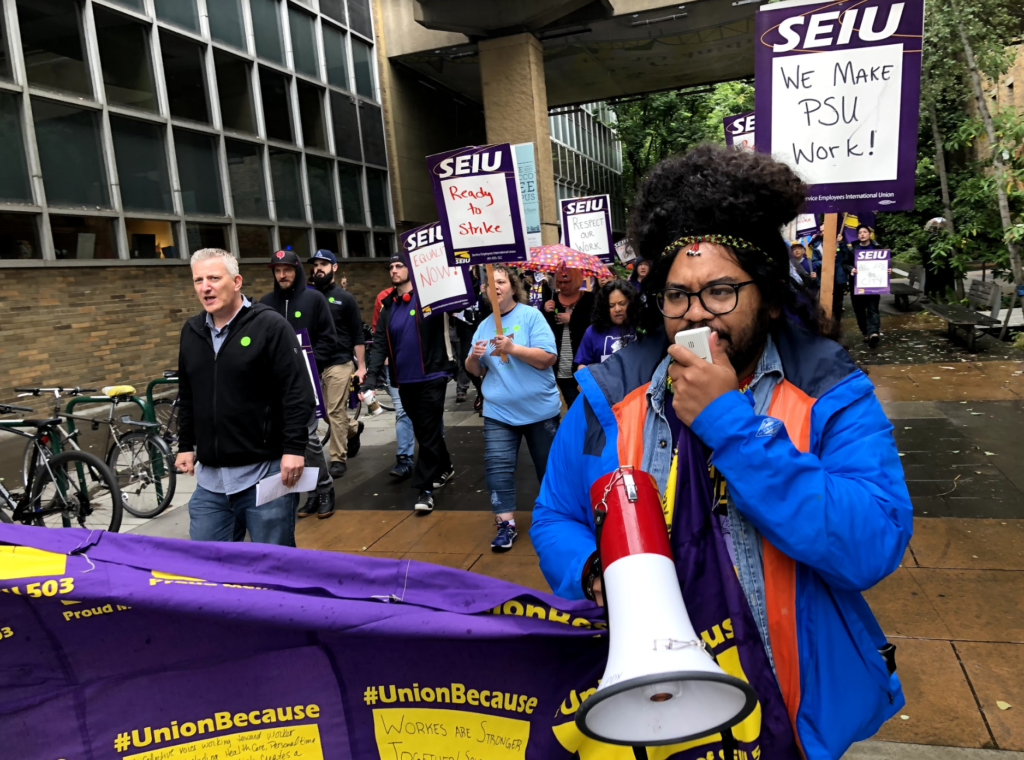Higher Ed workers will not settle for a contract that undervalues our work. It’s about respect!
Management at Oregon’s 7 public universities gave their “best and final” offer tonight. After weeks of tense negotiations, they chose to offer nothing new on key wage issues. Our bargaining team – representing approximately 5,000 classified workers at Oregon’s 7 public universities – will not accept a contract that does not value the work we do to keep our university system working.
“Today’s final offer by university management was the culmination of a disrespectful, insulting bargaining process,” said SEIU Executive Director Melissa Unger. “The universities continue to have the wrong priorities, they are raising tuition and refusing their lowest-paid workers a fair contract, while not addressing administrative bloat and administrative salaries. Their proposal does not reflect the value of these workers and we won’t settle for anything less than we deserve.”
If you don’t work in Higher Ed, please sign the community support petition.
Here are some key facts about Oregon’s public university system:
- Over 5,000 classified staff work at Oregon’s public universities. Sixty percent were paid less than $40,000 per year; 27% made less than $25,000 per year. Non-faculty represented staff averaged $36,136 per year in 2018. Many workers at colleges, universities, and professional schools earn so little they qualify for food and medical assistance. 1,485 university workers earned less than $2,177 per month, the income threshold for SNAP eligibility (food stamps) for a household of three.
- Oregon’s public universities employ too many supervisors and pay them out-sized salaries. Universities report 5.43 workers per supervisor. By way of comparison, Oregon’s state agencies averaged 9.84 workers per supervisor in December 2017. Lower ratios are a sign of administrative bloat and indicate opportunities to save costs by cutting overhead.
- Presidents of Oregon’s largest public universities are paid more than $600,000 a year, more than six times as much as Oregon’s governor. Four university coaches have a base salary of $1 million or more. There are 70 people who make $400,000 or more, and 411 who make more than $200,000.
- The additional $100 million in the budget is a 13.7% increase over the last budget.
Here are the current economic proposals from the Union and Management:
Union’s Proposal
- 3.75% COLA July 1, 2019
- 3.5% COLA July 1, 2020
- Regular step increases each year of the contract
- Add a step at the top and eliminate lowest step the first year of the contract
Management’s Proposal
- 0% (Not a typo) COLA in 2019
- 1% COLA March 1, 2020
- 0.75% COLA November 1, 2020
- 0.75% COLA March 1, 2021
- Year 1 – Regular full steps
- Year 2 – Delayed step increases for 6 months after salary eligibility date
- No new steps for workers who have topped out
Despite a strong economy and increased funding, management is proposing small wage increases. In addition to wages, management continues to put forward proposals that will make the universities a worse place to work and learn.
After workers reached an impasse following the latest round of mediated contract negotiations last Friday, management and workers had until today to submit final offers. Today begins a 30-day cooling period before the universities may implement their final offer and workers may go out on strike. The parties will continue to negotiate through the cooling off period and a potential strike until an agreement is reached.

